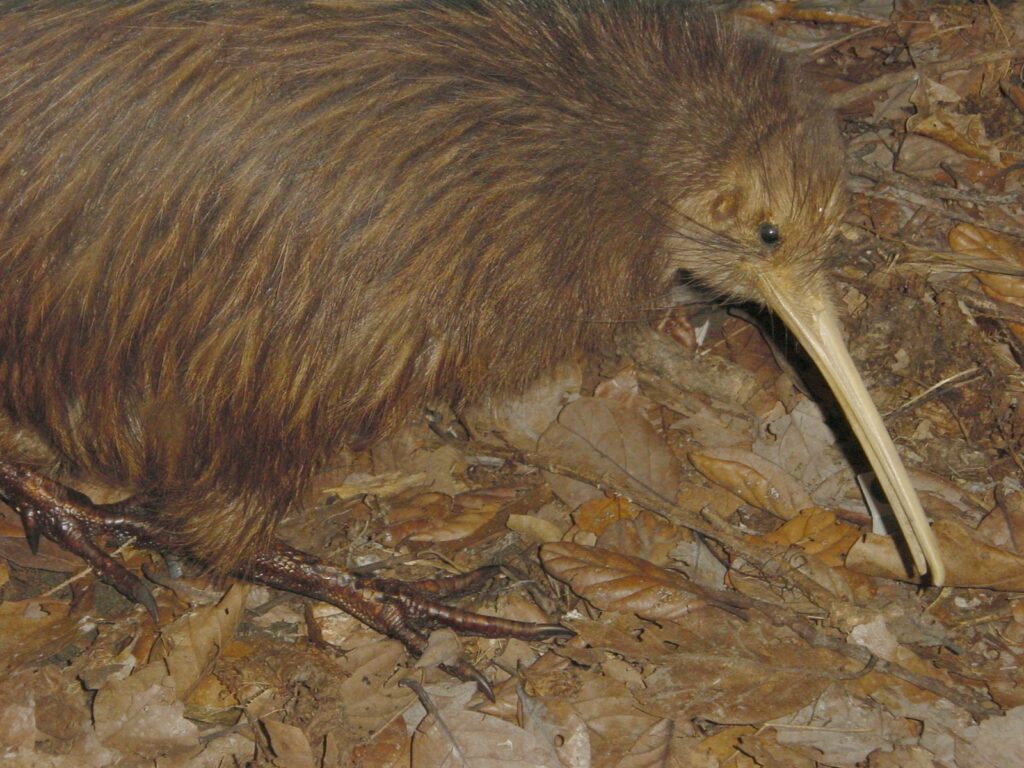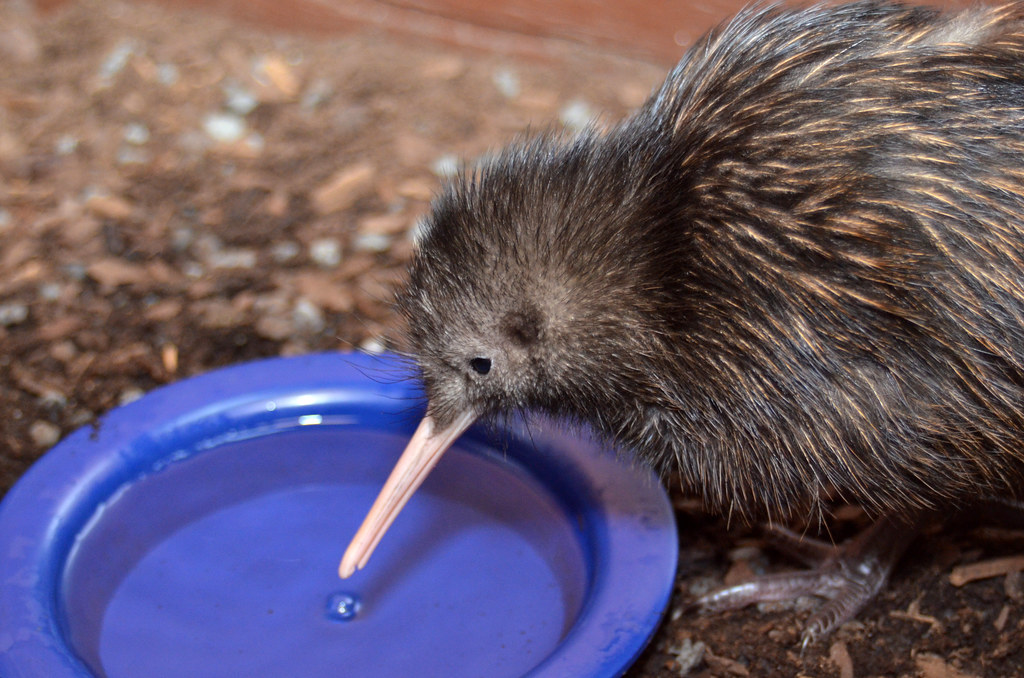The journey of the kiwi bird from an unusual flightless forest dweller to one of the world’s most recognized national symbols represents a fascinating tale of identity, conservation, and cultural pride. Native only to New Zealand, this remarkable bird with its distinctive appearance and unusual characteristics has transcended its biological significance to become the embodiment of a nation’s spirit. While many countries adopt powerful or majestic creatures as their emblems, New Zealand’s embrace of the small, vulnerable kiwi speaks volumes about the country’s values and self-perception. This article explores how a humble, nocturnal bird came to represent an entire nation, appearing on everything from currency and military badges to sports jerseys and global marketing campaigns.
A Bird Unlike Any Other

The kiwi’s journey to national symbolism begins with its extraordinary uniqueness as a species. Unlike typical birds, kiwis cannot fly, have hair-like feathers, nostrils at the end of their long beaks, and lay eggs that can weigh up to 20% of the female’s body weight. These peculiar characteristics made the kiwi stand out among New Zealand’s native fauna from the beginning. Scientifically classified in the ratite family alongside ostriches and emus, kiwis evolved in isolation on the New Zealand archipelago for millions of years without mammalian predators. This evolutionary path resulted in a bird so distinctive that it immediately captured attention and fascination, possessing qualities that would later make it an ideal national representative.
Māori Connections to the Kiwi

Long before European settlers arrived, the kiwi held special significance for the indigenous Māori people of New Zealand. Māori regarded the kiwi as taonga (treasure) and used its feathers to create prestigious kahu kiwi (kiwi feather cloaks) worn by chiefs and people of high status. In Māori mythology, the kiwi is connected to Tāne Mahuta, the god of the forest, who asked the bird to come down from the trees to eat the insects on the forest floor – explaining why the kiwi became flightless. These cultural connections established the kiwi as an important symbol within New Zealand long before it was formally adopted as a national emblem. The Māori respect for the kiwi laid important groundwork for its later elevation to national symbolism.
Colonial Era Recognition

During the colonial period of the late 19th century, New Zealand began seeking symbols to distinguish itself from Great Britain while establishing its own identity. The kiwi emerged as a distinctive emblem that was uniquely New Zealand, appearing on regimental badges as early as the 1880s. By 1887, the bird was featured on New Zealand’s one-pound note, marking an early official recognition of its symbolic importance. This period also saw New Zealand’s military units adopting “Kiwi” as a nickname during World War I, when New Zealand soldiers became known as “Kiwis” by their Allied counterparts. These developments during the colonial era represented the first steps toward the kiwi’s establishment as a national symbol rather than just a native species.
From Bird to National Identity

The transformation of the kiwi from merely a unique native bird to a symbol of national identity accelerated during the early 20th century. As New Zealand sought greater autonomy and a distinct identity separate from Britain, the kiwi offered a ready-made symbol that was unmistakably and exclusively New Zealand. The term “Kiwi” gradually expanded beyond referring to the bird itself to become a colloquial term for New Zealanders, reflecting how deeply intertwined the bird had become with national identity. This transition was not orchestrated through any single official declaration but evolved naturally through cultural usage and increasing appearance on official items. By mid-century, the kiwi had become so synonymous with New Zealand that citizens embraced the nickname “Kiwis” with pride, cementing the bird’s status as a national symbol.
Official Emblems and Currency

The kiwi’s position as a national symbol was formalized through its increasing presence on official emblems, insignia, and currency throughout the 20th century. The bird has appeared on various denominations of New Zealand coins, most famously on the one-dollar coin introduced in 1991 after decimal currency was adopted. Beyond currency, the kiwi has been incorporated into numerous government department logos, military emblems, and official seals. The New Zealand Defense Force continues to use the kiwi in its insignia, maintaining a tradition that began with the military units of World War I. This official representation across government institutions has reinforced the kiwi’s standing as more than just a cultural symbol but an officially recognized emblem of the state.
The Kiwi in Sports Identity

Sports have played a crucial role in cementing the kiwi as a national symbol on the international stage. New Zealand’s national sports teams across various disciplines are commonly known as the “Kiwis,” with the men’s national rugby league team officially adopting this name. The famous All Blacks rugby team, while not explicitly called “Kiwis,” often incorporates kiwi imagery in their branding and is instantly associated with New Zealand. The silver fern might share prominence in sporting contexts, but the kiwi remains an essential symbol that represents New Zealand athletes competing internationally. This sporting connection has been particularly important for spreading recognition of the kiwi as New Zealand’s symbol around the world, as millions of international spectators associate the bird with the nation through high-profile sporting events.
The Kiwifruit Connection

In an interesting twist to the kiwi’s symbolic journey, the fruit formerly known as the Chinese gooseberry was renamed “kiwifruit” by New Zealand exporters in the 1950s as a marketing strategy. This name change, capitalizing on the bird’s growing international recognition as a symbol of New Zealand, helped create a successful global brand for the fruit. The kiwifruit, despite not being native to New Zealand, became another ambassador for the country through its borrowed name. This commercial application of the kiwi symbolism demonstrates how deeply embedded the bird had become in New Zealand’s national brand by mid-century. The success of this marketing strategy further reinforced the bird’s international association with New Zealand, creating a mutually reinforcing relationship between the symbol and the nation’s commercial interests.
Tourism and Global Recognition

The kiwi has played a pivotal role in New Zealand’s tourism industry as both a literal attraction and a symbolic representation. Tourism New Zealand, the country’s official tourism organization, has consistently featured kiwi imagery in international marketing campaigns to establish an instantly recognizable brand identity. Visitors to New Zealand often seek opportunities to see the elusive bird in sanctuaries and protected areas, making kiwi conservation centers popular tourist destinations. The bird’s appeal extends from wildlife enthusiasts to general tourists who associate the creature with an authentic New Zealand experience. This tourism connection has further elevated the kiwi’s status by making it not just a national symbol but an international ambassador that draws visitors and interest to the country.
Conservation Efforts and National Pride

The kiwi’s rise as a national symbol has had the beneficial effect of raising awareness about conservation efforts to protect these vulnerable birds. With all kiwi species classified as either threatened or at risk, numerous conservation initiatives have been established to ensure their survival, including Kiwis for Kiwi and Operation Nest Egg. These conservation programs have received strong public support, reflecting how the bird’s national symbolism has translated into practical protection efforts. The relationship between the kiwi as a national symbol and conservation work creates a powerful feedback loop – as New Zealanders increasingly identify with the kiwi, they become more invested in its protection. This connection between national identity and conservation represents a unique aspect of how the kiwi functions as more than just a symbol but as a focus for active engagement with New Zealand’s natural heritage.
The Kiwi Character: Symbol of National Traits

Beyond its visual symbolism, the kiwi has come to represent certain characteristics that New Zealanders like to associate with their national character. The bird’s unassuming nature yet surprising resilience parallels how New Zealanders often see themselves – modest but tough, small but determined. Despite its inability to fly, the kiwi has adapted and survived for millions of years, reflecting New Zealand’s self-perception as a small nation that punches above its weight on the world stage. The nocturnal, somewhat shy nature of the bird also connects with the perceived humility and quiet confidence that New Zealanders value. This symbolic alignment between perceived national character traits and the kiwi’s natural characteristics has strengthened the bird’s position as not just a visual emblem but a metaphorical representation of national identity.
Kiwi in Popular Culture

The kiwi has permeated New Zealand’s popular culture, appearing in literature, art, advertising, and entertainment. Children’s books frequently feature kiwi characters, helping younger generations form early connections with this national symbol. Corporate branding throughout New Zealand often incorporates kiwi imagery or references, from Air New Zealand’s kiwi logo to countless small businesses that include “Kiwi” in their names. Television programs, films, and public art installations regularly feature the bird as a quintessential representation of New Zealand identity. This cultural saturation reinforces the kiwi’s symbolic status daily for New Zealanders and presents a consistent image to the outside world. The bird’s presence across all aspects of New Zealand popular culture demonstrates how thoroughly it has been embraced as more than just an official symbol but as a beloved cultural icon.
The Kiwi Versus Other National Symbols

While the kiwi stands as New Zealand’s primary animal symbol, it exists alongside other important national emblems such as the silver fern, the Southern Cross stars, and the color black. Each of these symbols serves different aspects of national identity, with the silver fern particularly prominent in sporting contexts and the Southern Cross appearing on the national flag. Despite this competition, the kiwi maintains its special status through its unique biological connection to the land – unlike the fern or stars, the kiwi exists nowhere else naturally. The relationship between these symbols is not competitive but complementary, with each representing different facets of New Zealand’s identity. The kiwi’s enduring prominence among these symbols speaks to its deeper resonance with both the land itself and the people’s conception of their distinctive place in the world.
International Perspective: How the World Sees the Kiwi

From an international perspective, the kiwi has achieved remarkable recognition as a symbol of New Zealand, creating an instant association that few national symbols around the world enjoy. Foreign visitors and media consistently use the kiwi as shorthand for all things New Zealand, demonstrating the success of the symbol in creating a distinctive national brand. The bird appears in international news stories about New Zealand, travel literature, and global cultural references whenever the country is mentioned. International sporting events frequently use kiwi imagery when referring to New Zealand teams, regardless of their official names. This international recognition represents the ultimate success of a national symbol – achieving immediate recognition and association beyond national borders while conveying something of the country’s unique character and natural heritage.
The Future of the Kiwi as a National Symbol

Looking ahead, the kiwi’s status as a national symbol seems secure, though its meaning continues to evolve alongside New Zealand’s changing identity. Conservation challenges remain critical, as the survival of the living bird is intrinsically linked to its symbolic power – a country cannot credibly maintain an extinct animal as its national symbol. Climate change, predator threats, and habitat loss pose ongoing challenges that will require sustained conservation efforts. At the same time, as New Zealand continues to develop as a multicultural society, the kiwi’s meaning expands to incorporate diverse perspectives beyond its traditional European and Māori associations. The bird’s future as a symbol will likely involve this continued evolution, potentially incorporating new meanings while maintaining its core connection to New Zealand’s distinctive place in the world.
Conclusion

The kiwi’s journey from a curious flightless bird to a powerful national symbol reflects New Zealand’s own development as a nation with a distinctive identity. Unlike many countries that chose powerful predators or majestic birds of prey as their national symbols, New Zealand’s embrace of the humble, vulnerable kiwi speaks to a national character that values uniqueness, resilience, and connection to the land over displays of strength or aggression. The bird has transcended its biological significance to become embedded in every aspect of New Zealand’s identity – from official emblems and currency to sports, tourism, conservation, and everyday cultural expressions. This remarkable transformation demonstrates how national symbols evolve not just through official designation but through organic cultural processes that reflect a nation’s deepest values and self-perception. As long as kiwis roam the forests of New Zealand, they will likely remain the beloved embodiment of a nation that sees something of itself in these extraordinary birds.
